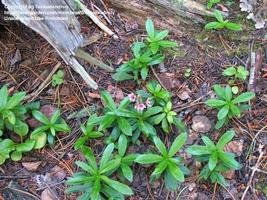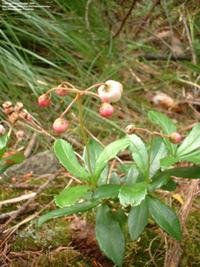





There was a tiny plant that was very scarce in the southeast Kentucky mountains. If I looked hard enough I could find it, and when I did I always sneaked around chewing on its leaf. It wasn't toxic, but I was never supposed to take a bite of a plant unless Aunt Bett was beside me directing every swallow.
I really was not a very good sneak. I usually got caught doing most of the things that I had been told not to do. I was a slick talker, though, and I could sneak by with just a small punishment, like my mother's threat to send me back to wherever I came from. She said it so many times, I often thought I might just vanish one day in a puff of smoke, never to be seen again. The worst thing that could ever happen to me was to be caught by Aunt Bett. And there were times when she did catch me.
Wintergreen and sassafras were always my downfall. I loved those two flavors, and at a time when candy and gum were in short supply, there was nothing better than the flavor of wintergreen or sassafras. I will save the sassafras for later, but there is much to be told about wintergreen.
Wintergreen is the name Aunt Bett gave it. I know it's more common name is the Native American word: Pipsissewa. Its more formal Latin name is Chimaphila umbellata, but for the sake of my own sanity, I think I will just call it wintergreen and bow to the medicine woman in my family. It does not freely grow in the mountains of my youth, because it needs drier woodlands and sandy soils, but I could sometimes find it on the edges of cliffs in the dry months of summer. It is a small evergreen perennial that grows to maybe 8 inches in height, and has shiny bright green, toothed leaves arranged in whorls along the stem. It blooms in July or August with white to pink flowers that are clustered at the end of an erect stalk. When bruised, the leaves have a peculiar taste that is sweetish and at the same time a bit bitter. I can find that same flavor in wintergreen gum and some flavored candies, but they never replicate the taste of chewing on a fresh leaf while I hid behind the tree so I wouldn't be caught.
The Native Americans used it as a medicinal plant, so it was not uncommon for Aunt Bett and me to go in search of it. The Indians thought the leather evergreen leaves contained a substance that was supposed to dissolve kidney stones, or so Aunt Bett said, but she didn't believe it. "Well, Aunt Bett, if you don't believe it, how come we are out here on this mountainside lookin' for it?"
"Chile, I swear, you could talk the legs right off a rooster, I reckon. Just cause them Cherokees used it for one thing, don't mean they din't use it for another. So we're looking to use it for other purposes," she said. I knew better than to say much more, If I got too much of her attention I wouldn't be able to sneak around chewing on a wintergreen leaf.
We gathered what we could find of it, and lagging behind in an attempt to chew the flavor out of that leaf for as long as possible, I went on down the mountainside with Aunt Bett. We cleaned the plants and stripped the leaves off the stems and laid them out on a screen on the back porch. To protect the drying leaves from critters and wind, we placed another screen on top. The screens, one on top of the other were placed on the backs of two ladderback chairs so that the air could circulate over and under to speed up the drying process. The porch was covered, so most of the drying was done there. I can't tell you that I didn't sneak a leaf or two occasionally, because even dry, it still retained its wintergreen taste. I was just careful and got caught only a time or two. Aunt Bett would say: "Chile, you been sneakin' them leaves again, ain'tcha?" I swear, I think she kept a daily count.
I learned from Aunt Bett that her ancestors steeped the leaves in warm water and applied the infusion externally to heal blisters. Sometimes the entire plant was pulverized and applied in wet dressings to reduce swelling of legs and feet. It was also used as a tea for a backache remedy and as a diuretic. She mentioned that there were other uses for it, drops for sore eyes being one of them, but I don't remember that she ever used it in any way except as a tea.
Until the early 20th century pipsissewa tonic was a staple home remedy in many rural households in this country, and even today its extract is a flavoring in candy and soft drinks, particularly in root beers.
Aunt Bett should never have worried, but if it hadn't been for her and my mother, I could still be munching on the leaves from the wintergreen plant. I have never found it here in the western part of the state so most of the time I run out and stock up on root beer. I learned early on to make do with whatever was available.
Thanks to Toxicondron and willmetge for the use of their photos from Plant Files.
Copyright © www.100flowers.win Botanic Garden All Rights Reserved